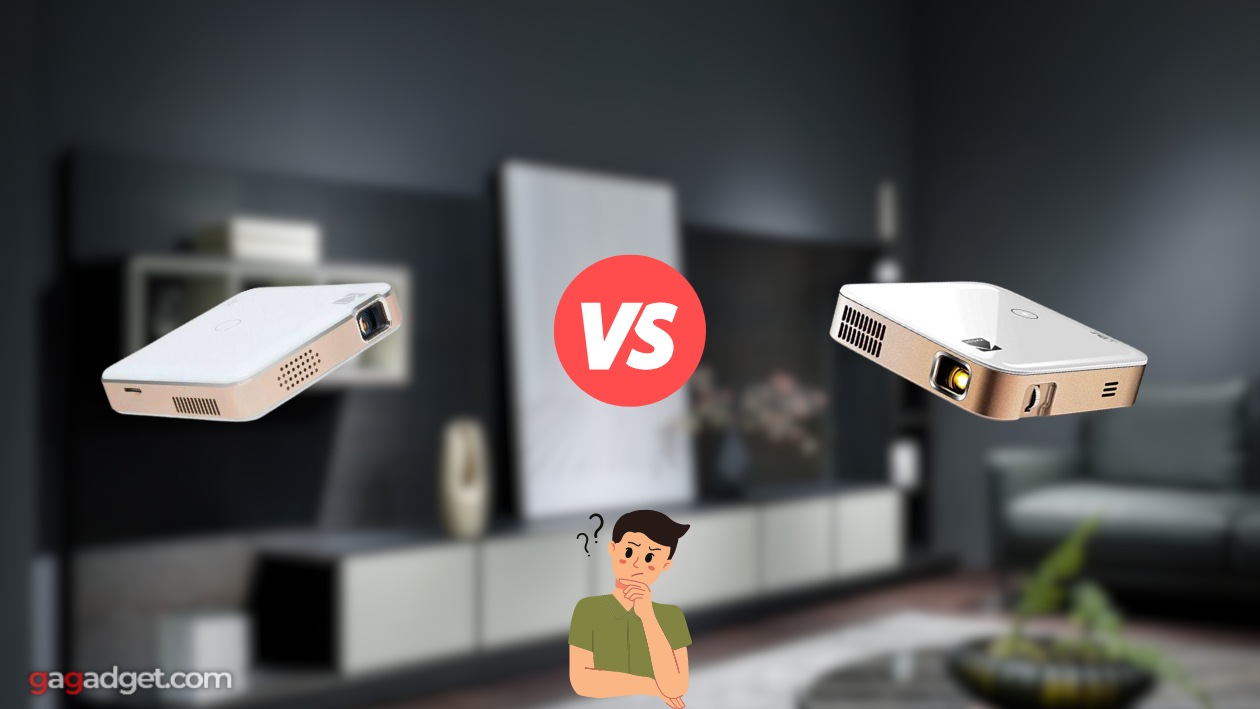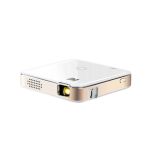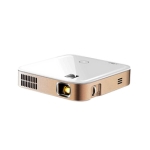At gagadget.com, your trust is our priority. We follow strict quality standards in our research, tests, and analysis of video projectors, to give you the best experience. Learn more
Kodak Luma 150 vs Kodak Luma 450: Comparison
Hey everyone, it's Jim. Today, I'm comparing two of Kodak's most popular portable projectors: the ultra-compact Luma 150 and the more feature-rich Luma 450. Both pack impressive functionality into tiny, go-anywhere designs. But their key differences in brightness, resolution, and smart features make each better suited for specific on-the-go uses and users.
I've spent quality hands-on time with both the Luma 150 and Luma 450, testing image quality, ease of use, streaming performance, and overall practicality. In this in-depth comparison, I'll share my experiences to help you decide which pint-sized projector is your perfect travel companion. Let's get started!

Kodak Luma 150 vs Luma 450: Quick Overview
I respect your time and aim to provide only the essential information, skipping the fluff.
If you're in a hurry, here's the quick rundown: The Kodak Luma 150 and Luma 450 are highly portable DLP projectors built for on-the-go entertainment. The main differences are size, brightness, and resolution. The Luma 150 is incredibly compact at just 3" x 3" x 0.8" and 0.22 lbs. But it tops out at 854x480 resolution and 150 LED lumens (60 ANSI). The Luma 450 delivers Full HD 1080p and 200 ANSI lumens in a slightly larger 4.4" x 4.4" x 1.3", 0.97 lb package. It also adds Android OS and more apps.
For most mobile users, I recommend the Kodak Luma 450. The Full HD resolution and 200 lumen brightness punch above its size class for movies and presentations. And the Android interface really extends its versatility. But if you want the tiniest projector possible and mostly view text documents or photos, the Luma 150's palm-sized form factor is incredibly convenient. Just set your expectations for its 480p resolution.
TAble of Contents
- Kodak Luma 150 vs Luma 450: Full Comparison
- Kodak Luma 450 vs Luma 150: Design
- Luma 150 or Luma 450: Owner Reviews
- Kodak Luma 150 and Luma 450 Alternatives
- Is the Kodak Luma 150 or Luma 450 Better for You?
Kodak Luma 150 vs Luma 450: Full Comparison
| Specs | Kodak Luma 150 | Kodak Luma 450 |
| Image |

|

|
| ANSI Lumens | 60 | 200 |
| Resolution | 854x480 (WVGA) | 1920x1080 (Full HD) |
| Contrast | 1,500:1 | 3,500:1 |
| Display Tech | DLP 0.2" | DLP 0.23" |
| Throw Ratio | 2.2:1 | 1.3:1 |
| Image Size | 13" - 200" | 20" - 170" |
| Lamp Type | LED | LED |
| Lamp Life | 30,000 hours | 30,000 hours |
| Battery Life | 2 hours | 3 hours |
| Android OS | No | Yes |
| App Store | No | Yes |
| Miracast | Yes | Yes |
| Wi-Fi | Yes | Yes (2.4GHz/5GHz) |
| Bluetooth | No | Yes |
| Keystone | No | Yes (vertical) |
| Dimensions | 3" x 3" x 0.8" | 4.4" x 4.4" x 1.3" |
| Weight | 0.22 lbs | 0.97 lbs |
| Year | 2020 | 2020 |
As you can see, the Kodak Luma 450 outclasses the Luma 150 in almost every technical category. The core of that advantage is the Luma 450's Full HD 1080p (1920x1080) resolution. This allows it to display much sharper detail, finer text, and an overall cleaner image than the Luma 150's WVGA (854x480) chip. In my side-by-side tests, the difference was stark, especially at screen sizes over 60 inches.
The Luma 450 is also brighter at 200 ANSI lumens versus the Luma 150's 60 lumens. That's over triple the light output - a significant margin you can easily see in rooms with some ambient light. The 450 maintains better color saturation and overall pop while the 150 looks more muted and washed out unless you're in total darkness.
I also observed superior contrast from the Luma 450, with deeper blacks, brighter highlights, and a more three-dimensional picture. That's borne out in the specs, where the 450 claims a 3,500:1 ratio compared to the 150's 1,500:1. Neither is a contrast champion like a home theater projector but for highly portable models, the 450 outperforms its size class.
The Luma 450 further distinguishes itself with a true Android operating system. This gives you access to a variety of pre-installed streaming and media apps like Netflix, YouTube, and a web browser. You can download additional apps from the included app store for even more content options. The interface is intuitive and the dual-band Wi-Fi keeps videos running smoothly.
In contrast, the Luma 150 offers wireless connectivity via 2.4GHz Wi-Fi only and uses a basic onboard media player, not a true OS. It works fine for playing files from the USB and microSD ports but doesn't have the rich app library or user-friendly navigation of the 450's Android UI. Both support Miracast screen mirroring from compatible devices.
Battery life is another win for the Luma 450 at 3 hours versus the Luma 150's 2 hours. That extra hour of playtime can mean the difference between finishing a long movie or presentation and anxiously looking for an outlet. Both batteries are rechargeable via an included micro USB cable for easy top-ups from a laptop or power bank.
Somewhat surprisingly given its higher performance, the Luma 450 also has a shorter throw ratio than the Luma 150. At 1.3:1 vs 2.2:1, the 450 produces a larger image from the same distance. For example, to get a 100" diagonal 16:9 picture, the 150 needs to be about 10 feet away while the 450 only needs 6 feet. That's a noticeable practicality advantage for small rooms and impromptu sessions.
Rounding out the 450's benefits are keystone correction (vertical only), Bluetooth connectivity for external speakers and controllers, and the ability to download a wider variety of apps from the Android store. The 150 lacks keystone and Bluetooth and only runs the pre-installed media player.
To be fair, the Luma 150 does beat the 450 in one key metric: size. At an incredibly compact 3" x 3" x 0.8" and 0.22 pounds, it's less than half the physical footprint and a quarter of the weight. It easily fits in a pocket and virtually disappears on a tabletop. If your top priority is maximum portability for slideshows, document viewing, and casual movie watching, it's tough to beat.
But for most on-the-go uses, I think the Kodak Luma 450's superior image quality, streaming flexibility, and still-travel-friendly design make it the smarter pick. The Full HD resolution and 200 lumen brightness elevate it from a novelty to a legitimately useful portable theater for movies, presentations, and entertainment. The 150 is more strictly a quick-hit solution with notable compromises in clarity and functionality.
Kodak Luma 450 vs Luma 150: Design
Kodak Luma 150 Design
Kodak Luma 450 Design
The Kodak Luma 150 measures just 3" square and 0.8" thick, with a scant 0.22 pound weight. The Luma 450 is a bit chunkier at 4.4" square, 1.3" thick, and 0.97 pounds. Subjectively, the 150 almost disappears in a pocket while the 450 is about the size of a thick paperback novel.
Input-wise, the 150 gives you a single HDMI port, USB port, and a microSD card slot. The 450 drops the card reader but thankfully keeps HDMI and USB for external media sources and thumb drives. Both also have a 3.5mm audio output jack for headphones or a powered speaker.
Luma 150 or Luma 450: Owner Reviews
Let's see what actual buyers have to say about their experiences with the Kodak Luma 150 and Luma 450 portable projectors:
Kodak Luma 150 Owner Reviews:
Praises: "I can't believe how small this projector is - it literally fits in the palm of my hand. Perfect for slipping in a bag for trips and office presentations."
"The picture quality is surprisingly decent for the size and price. Obviously not HD but good enough for PowerPoints and casual movie viewing."
***
Drawbacks: "The 480p resolution is pretty low by modern standards. Fine text and details get muddy, especially at larger screen sizes."
"60 lumens is very dim, even in a totally dark room. The image washes out easily with any ambient light. Don't expect vibrant colors or contrast."
Kodak Luma 450 Owner Reviews:
Praises: "I'm blown away by the picture quality from such a portable projector. Full HD resolution and 200 lumens is no joke - it's bright, sharp, and colorful enough for real movie nights."
"The Android interface is super handy. I just connected to Wi-Fi and started streaming Netflix right from the projector, no external devices needed."
***
Drawbacks: "The built-in speakers are pretty weak and tinny. Fine for a small room but you'll definitely want external audio for the best experience."
"The short throw lens is great for small spaces but doesn't give you much wiggle room for placement. You need to be pretty precise with the distance to get a focused image."
Overall, owners of both projectors seem generally satisfied given the limitations of the ultra-portable class. Kodak Luma 150 buyers love the palm-sized form factor and appreciate the image quality for its diminutive dimensions. But many note the low resolution and brightness make it best for casual or short-session use in dark environments.
Kodak Luma 450 reviewers are more universally enthusiastic, praising the Full HD sharpness, ample light output, and Android OS flexibility. Several call it a legitimate replacement for a TV on the road. The main complaints are weak onboard audio and some finickiness with placement due to the short throw.
From my testing, I agree the Luma 450 delivers an impressive overall experience for its size while the Luma 150 is more of a novelty with situational utility. The 450's 1080p resolution and 200 ANSI lumens make a huge difference in perceived clarity, color, and versatility. It's a projector I could legitimately use as a TV substitute in a hotel room or for a movie night while camping.
Kodak Luma 150 and Luma 450 Alternatives
If you're not sold on the Kodak Luma 150 or Luma 450, here are a couple other popular pico projectors to consider:
- AAXA P7 Mini: A 1080p LED projector with Android OS, 30,000-hour LED life, 2+ hour battery, and a lightweight 13 oz design. 600 lumens and dual 2W speakers;
- Xgimi MoGo Pro: A premium pocket projector with 1080p resolution, 300 ANSI lumens, Android TV 9.0, auto focus/keystone, and a 10,400mAh battery. Pricey but powerful.
The AAXA P7 Mini is a close match to the Kodak Luma 450 with the same core 1080p resolution and Android OS. But it cranks the brightness to 600 lumens (unspecified ANSI) and adds a couple extra adjustment options like manual focus and ±40° digital keystone. Battery life and internal storage are comparable at 2+ hours and 8GB respectively.
For a step up in both performance and price, the Xgimi MoGo Pro is hard to beat. The 1080p resolution, 300 ANSI lumen output, and Android TV smarts closely resemble the Luma 450. But it adds auto focus and keystone correction plus a larger 10,400mAh battery good for up to 4 hours of playback. The build quality and audio are also a cut above. Just be prepared to pay a premium for the privilege.
Is the Kodak Luma 150 or Luma 450 Better for You?
After extensive hands-on testing, it's clear the Kodak Luma 450 is the superior portable projector for most users compared to the Luma 150. The 450's 1080p resolution, 200 ANSI lumen brightness, Android OS, and 3+ hour playtime make it a legitimately viable TV replacement for movies, shows, and presentations on the go. Yes, it costs a bit more and fills a coat pocket rather than a pants pocket. But the dramatically better image quality and functionality are well worth the tradeoff for me.
That's not to totally dismiss the Luma 150. If you really value the absolute smallest projector possible and mostly plan to view basic documents, slideshows, or casual videos, it remains an appealing option. The 480p resolution and 60 lumen output are weak by modern standards but sufficient for those less demanding applications on smaller screens. And there's no denying the cool factor of a projector that fits in the palm of your hand.
Ultimately, it comes down to your personal priorities and intended uses. Need max brightness, clarity, and streaming convenience for genuine on-the-road entertainment? Spring for the Kodak Luma 450. Just want an ultra-compact, affordable projector for occasional office presentations or movie nights? The Kodak Luma 150 gets the job done.
Whichever you choose, just set your expectations accordingly. Neither will rival a full-size home theater projector for image quality or features. But for their incredibly portable designs and low prices, both deliver a lot of fun and flexibility for popping up a big screen virtually anywhere. If you can embrace their limitations, you'll be thrilled with how much easier they make it to share and enjoy your digital media.
Thanks for reading! Let me know if you have any other questions as you're deciding on your ideal pocket projector. I'm always happy to help you break down the key factors to find your perfect travel companion.
Go Deeper:






